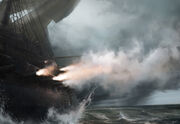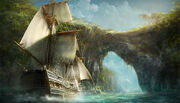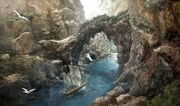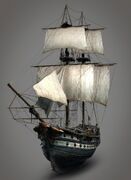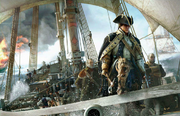- "Who is she? Why the Aquila, boy! The Ghost of the North Seas! ... She's a ship, boy, and make no mistake about it!"
- ―Robert Faulkner to Connor about the Aquila
The Aquila sailing into battle against the Dartmoor
The Aquila was a naval warship during the Seven Years' and American Revolutionary Wars, which earned her the nickname "Ghost of the North Seas". During the American Revolution, the vessel was captained by the Assassin Connor, with Robert Faulkner as his first mate. Under their command, the Aquila helped to bring the rogue Continental captain and Templar Nicholas Biddle to heel, who had been raiding locations along the coast. They also patrolled several trade routes along the Eastern Seaboard and the Caribbean Sea.
History
- "She's still the fastest in the Atlantic - sure she needs some attention... minor things mostly but with a little affection she'll fly again."
- ―Robert Faulkner discussing the repairs needed on the Aquila
The Aquila was constructed in Brest, France, in the year 1749 and soon became the flagship of the Assassin navy. While small in design, the Aquila was a fast ship for her size, capable of twelve knots in a good wind, according to Faulkner, making her one of the fastest in her region of service. Armed with heavy cannons and accurate swivel guns, the Aquila had a versatile and powerful arsenal that made her a force to be reckoned with.

The destroyed Aquila in the Davenport Homestead's harbor
In 1754, after suffering heavy damage pursuing the Providence through a storm, the Assassins spread the word that the Aquila had been destroyed. In reality, she had only sustained minor damage and was soon refitted for combat. Over the next decade, the Aquila plagued the Templar fleets, earning herself the moniker of "Ghost of the North Seas", an illusion spread both by the ship avoiding major harbors and by the exceptional sailing ability by her acting captain, Robert Faulkner. Eventually, the Templars uncovered the fact that the Aquila had not been destroyed and, in 1768, three British frigates ambushed and nearly destroyed the ship. Both the Aquila and Faulkner survived and managed to escape to the Davenport Homestead, where they would remain until the arrival of the Assassin Connor, who decided to pay for the vessel's repairs.
Once repaired, Connor and Faulkner found a crew for the Aquila and sailed to Martha's Vineyard in search of cannons and officers. Faulkner recruited some of his old shipmates, David and Richard Clutterbuck, as gunnery officers and tutored Connor in sailing the Aquila as captain. After practicing to fire the cannons at an old shipwreck, the Aquila saw her first fight in years against a patrol of British gunboats and a frigate.
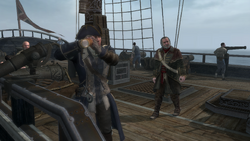
Captain Connor and Faulkner on deck
Following this, Connor used the Aquila to defend trade routes along the Colonial seaboard and the Caribbean. The Aquila was called upon to defend a number of trading vessels, such as the Henderson and Independence, securing trade routes for the colonists and reducing the risk of merchants. Privateers and English frigates were terrorizing the coast, and the Aquila's patrols put her in a premier position to eliminate the threats. Gunboats and frigates were among the privateers' favored ships, though they occasionally had a few larger ships to rival the Aquila, such as the Dartmoor, Saint James, and Prospector.
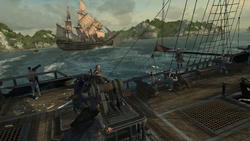
Connor and Haytham hunting the Welcome
The ship also served as transport for her captain when Connor sought out the hidden treasure of Captain William Kidd and traveled in pursuit of Templars. Often, this meant the Aquila waited offshore while Connor and Faulkner went ashore in a rowboat to exlore the maps Peg Leg had given him in return for trinkets. These locales varied greatly, from a jungle beach to the icy north. However, on some occasions, the Aquila was directly used in hunting a Templar. Haytham Kenway and Connor, during their brief armistace, used the Aquila in the hunt for Benjamin Church and the Welcome in the Caribbean Sea, eventually boarding the ship, retrieving her stolen cargo for the Patriots at Valley Forge, and killing her passenger.
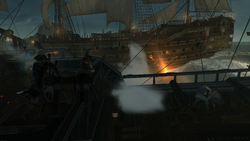
The Aquila faces off with the USS Randolph
The Welcome was not the Aquila's only prey -- Nicholas Biddle had been raiding Martha's Vineyard in the USS Randolph. The troubles started when privateer frigates threatened merchant vessels near the Vineyard, and the Aquila successfully found and defeated their fort headquarters. When another merchant vessel was threatened, the USS Randolph was spotted leading the privateers, though she escaped through a storm. For several years thereafter between 1776 and 1778, Connor and the Aquila hunted Biddle and the USS Randolph, thought to be the party responsible for inciting the privateers to raid the Vineyard and the ships visiting it. The Aquila was delayed by needing to help the La Belladonna, vital to the war effort, and other constraints on her captain's time. Eventually, however, in 1778, Connor and the Aquila managed to corner the USS Randolph, disable her, kill her captain, and scuttle her, securing the Vineyard and stopping the Templars from encouraging further attacks.

The Aquila sailing into battle at the Chesapeake
When the Battle of Chesapeake Bay began, Lafayette requested the Aquila to give support in the battle. The French Admiral de Grasse believed that he would receive a large fleet and experienced captains, but instead he received the Aquila and her captain Connor. While irritated at the concept, de Grasse gave Connor two frigates for assistance, the Marsellois and the Saint Espirit. During the battle, the trio of ships sank several gunboats and at least four English frigates, before the Marsellois was destroyed by an English vessel midway through the battle. Once all the English frigates had been destroyed, a Man-of-War sailed into the battle and sank the Saint Espirit, before she managed to disable the Aquila's guns. Due to lacking any other means of attack, Connor decided to attempt to destroy the Man-of-War by ramming her, getting on board and killing her captain. On ultimately proving successful, the battle ended with the French as the victors.<
Armaments
- "We've fitted her with a modest amount of guns to start but rest assured there's ample room to add more should you feel the need."
- ―Robert Faulkner on the Aquila's first fitting under Connor
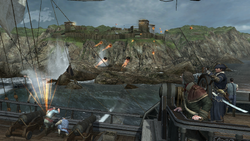
The Aquila's firing heated shot upon a fort
Although relatively well built, even when initially repaired by Connor, the Aquila underwent several major improvements during his captaincy. In addition to the warship's standard round shot and swivel guns, the Aquila was eventually upgraded to include several more projectile types: chain-shot to destroy a ship's sails, disabling them; grapeshot to target the crew; and heated shot to start fires among the hull. The Aquila also received improvements in her hull strength via reinforcements, an improved rudder for sharper turns, and the addition of a naval ram. Fully upgraded, the Aquila was armed with 60 main cannons, 30 on each side. This would have made her equivalent in firepower to a third-rate ship of the line, which meant that she would have been a smaller ship of the line but larger than a frigate. Most contemporary 60-gun ships carried those guns on only two decks; however, the Aquila carried them on two dedicated gun decks with a few cannons and the swivel guns also present on the weather deck.
Trivia
- "Aquila", the Latin word for "eagle", was a reference to the eagle motif of the Assassins.
- Continuing the eagle theme, the Aquila had an eagle-shaped figurehead.
- "Aquila" was also the name of a constellation, with its brightest star known as "Altair", which was also the namesake of Altaïr Ibn-La'Ahad.
- In an interview, Mission Director Philippe Bergeron stated that Connor could freeroam the seas with the ship between missions. However, this was not possible in the final version of Assassin's Creed III.
- The Aquila had lifts attached to her central mast, with the pulley handles shaped as Assassin insignias.
- Faulkner stated the Aquila's top speed was 14 knots, but her actual in-game speed was closer to 60 knots, which was not reached by any real ship until 1911.
- By the number of guns and masts, the Aquila would be considered a third-rate ship-of-the-line. While not as massive as a first-rate or second-rate, the third-rate ships were considered to be the ideal balance in sailing warships in terms of speed and firepower. This would also mean that she had a crew complement between three and five hundred men.
Gallery
Reference



